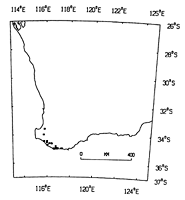

 |
 |
|
Chorizema retrorsum J.M.Taylor & Crisp, Aust. Syst. Bot.
5: 315, Figs 41, 42 (map) (1992).
Type: Western Australia: between Walpole and Denmark, road to Valley of the Giants, 34° 57' S, 116° 55' E, J.M. Taylor 1978 & P. Ollerenshaw, 19 Sep. 1983 (holo: CBG; iso: MEL, PERTH).
Vigorous shrubs; stems often scrambling, ± flexuose, up to c. 3 m long; indumentum of spreading or appressed hairs, becoming scabrous or rarely almost glabrous with age. Leaves alternate, ovate, narrow-ovate or -oblong, obtuse or acute at the apex, on the margin spinous-toothed or -lobed with at least some retrorse spines present, 35–100 x 8–45 mm, undulate, coriaceous, with scattered, appressed or spreading hairs, dull green; venation reticulate; petioles 2–4 mm long; stipules subulate, 1.5–4 mm long. Racemes terminal and axillary, to 30 cm long with c. 16 flowers, those in the axils shorter and bearing fewer flowers. Pedicels 3–5 mm long; bracts ovate or narrow-ovate, acute, 1.5–2 mm long, persistent; bracteoles ovate or narrow-ovate, acute, 1–1.5 mm long, attached at the base of the calyx, persistent. Calyx 9–10.5 mm long, with appressed or spreading short hairs; calyx-lobes almost twice as long as the tube; upper two lobes united, the tips acute, free 2–3 mm; lower three lobes narrow, acute, 6–7 mm long. Corolla: standard broad-ovate, emarginate, 16–20 x 12–18 mm including a broad, thickened claw 4.5–6 mm long, apricot or orange with yellow markings; wings obliquely obovate or spathulate, often shallowly retuse, abruptly narrowed and curved near the middle, auriculate, 15–18 x 5–8.5 mm including c. 2.5 mm claw, bright pink or magenta; keel oblong, obtuse or acute at the apex, auriculate, 9–10 x 2–3 mm including c. 2.5 mm claw, greenish yellow. Stamens with filaments 6–8 mm long; anthers versatile, c. 0.4 mm long. Gynoecium shortly stipitate, 8–9 mm long including the straight or slightly incurved style c. 5 mm long; stigma capitate, c. 0.4 mm broad, surrounded by minute hairs; ovary with dense, long, white hairs; ovules 25–35. Pod scarcely stipitate, ellipsoid-obovoid, acute, turgid or slightly compressed, 14–17 x 5–6 mm. Seeds reniform, c. 2 x 1.25 mm, brown, shiny.
Mainly September to December with a few collections recorded in July and August.
November to December. Old pods persistent.
WESTERN AUSTRALIA. Walpole, J.S. Beard 5786, 3 Nov. 1968 (PERTH); Walpole N.P., Knoll Drive Picnic Area on channel below Walpole Inlet and Nornalup Inlet, 34° 59' S, 116° 43' E, S.J. Forbes 1149, 16 Oct. 1982 (CBG, MEL); Denmark, C.A. Gardner s.n., 7 Nov. 1927 (PERTH); Mount Frankland, C.A. Gardner 18000, 12 Nov. 1960 (PERTH); 6 miles [9.7 km] S of Northcliffe, A.S. George 2642, 22 Jul. 1961 (PERTH); Bow River, N of Highway, C.H. Gittins 1756, Sep. 1967 (BRI, NSW); Mt. Glare, Walpole, V. Mann 88 & A.S. George, 12 Nov. 1969 (K n.v., PERTH); Boat Landing Rd, 15 miles [24 km] W of Pemberton, S. Paust 289, 8 Sep. 1971 (PERTH); Between Walpole and Denmark, road to Valley of the Giants, 34° 57' S, 116° 55' E, J.M. Taylor 1977 & P. Ollerenshaw, 19 Sep. 1983 (CBG, MEL, PERTH); 25 km SE of Brockman National Park, c. 34° 30' S, 116° 00' E, T. & J. Whaite s.n., 10 Oct. 1976 (NSW 152038).
 Distribution
DistributionWestern Australia: Darling district. Chorizema retrorsum occurs in the south-west centered around Walpole, Shannon and Denmark, with collections recorded from further north at Pemberton, Nannup and Donnybrook.
Chorizema retrorsum has been recorded growing on a wide variety of soils including red loam, sandy loam and gravel, laterite, and conglomerate clay. Associated vegetation may be tall Eucalyptus forest with E. calophylla, E. diversicolor, E. jacksonii or E. marginata dominant, often with a dense understorey which may include Acacia pentadenia and Agonis.
Chorizema retrorsum bears a superficial resemblance to the other holly-leaved species, viz. C. cordatum, C. ilicifolium, C. nanum and C. varium. It can be distinguished by its vigorous, scrambling habit, the ovate, narrow-ovate or -oblong leaves with retrorse spine-tipped teeth or lobes along the margin, the calyx-lobes about twice as long as the tube, and the almost straight style with a conspicuous capitate stigma. The other four species are usually less vigorous, never scrambling, with leaves ovate or cordiform, the teeth rarely retrorse, calyx-lobes more or less as long as the tube, the style hooked or strongly incurved and the stigma not conspicuous.
Although C. retrorsum has been collected many times since the earliest collections of Maxwell, undated, and Mueller, 1877, specimens usually have been determined as C. cordatum or C. ilicifolium.
[Source: Taylor, J.M. and Crisp, M.D., "Revision of Chorizema." Australian Systematic Botany 5: 249-335 (1992)]